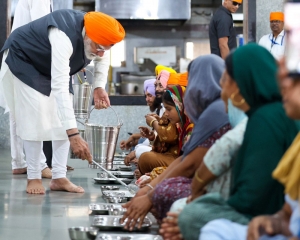India has witnessed the highest number of deaths in Asia because of extreme weather in the last two years leading to large-scale migration of people from one place to another, taking climate scientists and meteorologists by surprise.
The State of India’s Environment Annual report says that in terms of deaths, 48 per cent of the deaths in Asia due to extreme weather events happened in India.
In 2019, 2,038 people died due to extreme weather conditions compared to 1,396 in 2018.
Extreme weather events include conditions like drought, wildfire, flood, landslides, extreme temperatures, fog and storm.
The State of India’s Environment report says: “The continuity of extreme events from one month to the next means that the world needs to always be on its toes. Scientists and environmentalists have called this a climate emergency.”
Dr Shiraz A Wajih from Gorakhpur Environment Action Group says that months after months, India has witnessed vagary of weather. If in one particular month it had rained in one parts of the country, there was drought in other part that led to migration.
The report further says that in 2019, if north-east witnessed the end of the north-east monsoon season with a 44 per cent deficit rain, north India had one of the coldest and driest winters ever. In March, an unseasonal heat wave roasted Tamil Nadu, Andhra Pradesh and Kerala. In April, thunderstorms with cloud-to-ground lightning strikes began affecting states in east, central and north-east India. The month ended with the formation of a rare pre-monsoon cyclone (Fani).
May and June were marked by a spate of heat waves.
“By the first week of June, the country had undergone 73 spells of heat wave conditions, 11 of them extreme; with the maximum deaths in Bihar The conditions were so harsh that district magistrates of five districts invoked Section 144 of the Criminal Procedure Code to restrict public activities during daytime,” the report said.
There was delay in the onset of south-west monsoon, and July started with a weak rainfall. But once it started raining, it poured. Twelve states received over 60 per cent surplus rains in the second week of July. The resultant floods in Bihar and Assam affected over 10 million people and claimed 168 lives.
“The rains came in short bursts of heavy downpours followed by drier periods, a pattern that continued till September. In all, there were 1,250 events of extreme rainfall during the year, or more than three per day,” the report said.
In October and November, cyclones Hikaa, Kyarr and Maha in the Arabian Sea and cyclone Bulbul in the Bay of Bengal formed and intensified in quick succession. With cyclone Pawan in December, the total number of cyclones in the northern Indian Ocean region reached eight. This is the highest number of cyclones in a single year since 1976.
The biggest impact of the climate change was on human migration. With increasing intensity and frequency, natural disasters now affect more than half of India’s population, both in rural and urban areas.
According to the National Disaster Management Authority, 27 of the 37 states and Union territories are disaster-prone. Some 68 per cent of the cultivated land is vulnerable to drought, 58.6 per cent landmass is prone to earthquakes, 12 per cent to floods, 5,700 km of the coastline is prone to cyclones and 15 per cent of the area is susceptible to landslides.
The 2011 Census shows that 405 million (or 33 per cent) of the country’s population are on the move, with some 9.9 million people migrating from one state to another every year.
Sunitha Krishnan from Prajwala, who is working with trafficked women in Andhra Pradesh and Telangana, said that displacement or rise in migration due to disasters has raised concerns on increasing human trafficking.
“There is a clear evidence of linkages between disaster, migration and vulnerability to human trafficking. Even the UN Environment Programme estimates that trafficking goes up by 20-30 per cent during disasters,” she said.
Extreme weather conditions behind large-scale migration India records highest deaths in Asia
Monday, 17 February 2020 | PNS
| Lucknow
Extreme weather conditions behind large-scale migration India records highest deaths in Asia
Monday, 17 February 2020 | PNS | Lucknow

























